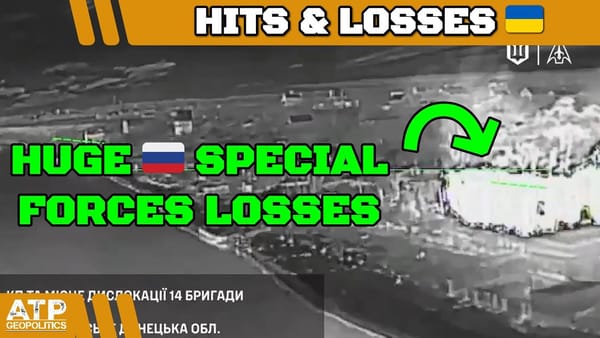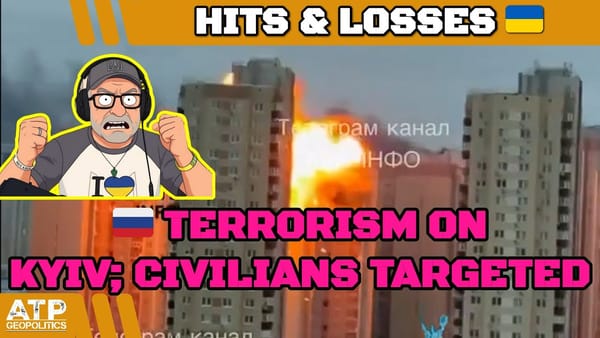Ukraine War Update NEWS: AP's Equipment Loss List
Table of Contents 📖
"They're using bloody golf carts and motorcycles and bukankas."
Hello Team
🎦 00:00-00:15⏩
Jonathan welcomes viewers to another ATPG video. This video is an addendum to the day's first video, focusing on Andrew Perpetua's recently released equipment loss statistics. Due to the extensive nature of the data, Jonathan will focus this update specifically on losses.
Return to top⤴️
🪦 DISCLAIMER FOR GENERAL STAFF LOSSES DATA
- These are real people with real lives and real families who love them. Don’t let the numbers sap your humanity.
- These numbers probably aren’t accurate but they’re the best we have and we don’t need them to be accurate to be indicative of patterns of activity.
- All losses are estimates. Losses cannot be counted with accuracy because of the conditions on the ground.
- Both sides would see it to be of their advantage to minimize their own losses maximize the other side’s losses.
- Neither side releases their losses but we have enough transparency from the Ukrainian side to have confidence in they are indicative.
- Personnel losses are hard to count. If a soldier gets injured, heals up, and returns to the front line only to get injured again, is that one loss or two? Also, how to deal with losses from PMC’s or soldiers fighting with RF from occupied territories?
- Equipment losses are hard to count. If an AA complex involves several parts and one part gets disabled, is that a loss, or a fraction of a loss? If a tank gets disabled, repaired, back into the fight, then disabled again, is that one lost tank or two?
- All recorded losses are vulnerable to multiple reporting. We have already seen numerous cases of multiple drones in the air reporting the same loss from different angles as multiple engagements.
- Losses are not always reported on the same day they occurred. It is frequent that drone losses are reported at least 24 hours after other terrestrial equipment losses. Certain losses may not be reported for days or weeks for military intelligence reasons.
Overview of Andrew Perpetua's Loss Statistics
🎦 00:15-03:25⏩
Jonathan highlights Andrew's efforts in separating civilian losses from military equipment losses. The data reveals a 3:1 loss ratio in favour of Ukraine when considering all vehicles (civilian and military). However, the ratio narrows to less than 2:1 for combat losses alone, which is not ideal for Ukraine. Jonathan notes that this ratio may not include ATVs and trucks. He also observes that Ukraine has a better ratio of damaged to destroyed military equipment compared to Russia's predominantly destroyed equipment. Despite this, Jonathan emphasizes the value of all equipment, particularly for Ukraine.
Return to top⤴️
Ukrainian Military Equipment Losses
🎦 02:25-03:25⏩
Jonathan details Ukrainian losses, which include a decoy, a high-value AN/TPQ-48 radar (essential for air defense), boats, artillery pieces, tanks, and infantry fighting vehicles (IFVs). Notably, four of the six lost IFVs were Bradleys, and both the APC and MRAP were Western-supplied (a Humvee and a MaxxPro), indicating Ukraine's increased reliance on Western equipment. Jonathan expresses concern over the radar loss, highlighting its significance for Ukraine's military capabilities.
Return to top⤴️
Russian Military Equipment Losses
🎦 03:25-04:00⏩
Russian losses, according to the data, include an engineering vehicle, boats, a variety of artillery pieces (mostly older models), tanks (T-72s, T-80s, and others), BMP-2 and BMP-1 IFVs (largely destroyed or abandoned), MTLB and Tiger APCs, Ural trucks, Desert Cross 1000 3s, and four-wheelers. Jonathan points out that while Russia lost a substantial amount of equipment, it may not be as significant from a military combat perspective as Ukraine would hope.
Return to top⤴️
Analysis of Civilian Vehicle Losses and Impact on Personnel
🎦 04:00-05:53⏩
Jonathan shifts focus to civilian vehicle losses, where Ukraine has a significant advantage. Ukrainian forces have destroyed a substantial number of Russian "bukankas" (a colloquial term for homemade light vehicles, often used for military purposes), motorcycles, pickup trucks, and communications equipment. Conversely, Ukrainian losses consist mainly of pickup trucks. Jonathan suggests that the destruction of Russian "bukankas," motorcycles, and Desert Cross 1000 3s (often targeted by Ukrainian drones) likely resulted in significant Russian personnel losses and injuries. He underscores this point by mentioning the day's reported Russian personnel loss of 1,180, a considerable figure.
Return to top⤴️
Russian Claims vs. Evidence: Questioning the Narrative
🎦 05:53-06:25⏩
Jonathan addresses discrepancies between Russian claims and available evidence. He highlights two specific instances:
- The "lance hit" on a howitzer: Andrew Perpetua's data lists this as a "tree decoy," implying the howitzer was not hit.
- The Iskander missile strike on a helicopter: Jonathan, referencing a previous video, remains unconvinced about the helicopter being destroyed, suggesting the video evidence is not conclusive.
Russian Targeting of Civilian and Emergency Service Vehicles: An Act of Terrorism
🎦 06:25-07:08⏩
Jonathan condemns Russia's deliberate targeting of civilian and emergency service vehicles, citing a video shared by Andrew Perpetua on Twitter that shows a Ukrainian police drone SUV being hunted down and destroyed. Jonathan criticizes these attacks, labelling them as acts of terrorism and emphasizing that Russia is intentionally targeting civilians and emergency services personnel carrying out their duties.
Return to top⤴️
Appreciation for Andrew Perpetua's Work
🎦 07:08-07:38⏩
Jonathan expresses gratitude for Andrew Perpetua and his team's dedication to identifying, geolocating, categorizing, and presenting this valuable data. He encourages viewers to support Andrew's work through his Twitter and consider donating via the provided links on his map. Jonathan emphasizes the significance of this information for public understanding of the conflict.
Return to top⤴️
Analysis: Deciphering Equipment Losses and Russian Tactics
🎦 07:38-09:31⏩
Jonathan provides a final analysis of the loss data, arguing that while seemingly positive for Russia (fewer combat losses), it potentially masks deeper issues. He suggests that the lower combat losses might indicate a depletion of key military equipment, forcing the Russians to rely on less conventional vehicles. This reliance on civilian vehicles, as evidenced by Ukrainian strikes on "bukankas," motorcycles, and other civilian vehicles, reveals a desperate shift in Russian tactics and further highlights the challenges they face. He recalls the Bucha footage showing numerous destroyed motorcycles and a few APCs, illustrating the use of civilian vehicles in military operations and the devastating consequences. Jonathan concludes that the data tells a story beyond simple numbers, providing a glimpse into the reality on the front lines.
Return to top⤴️
Wrap Up
🎦 09:31-09:38⏩
Jonathan expresses his gratitude to Andrew Perpetua and bids farewell to his viewers.
Return to top⤴️



